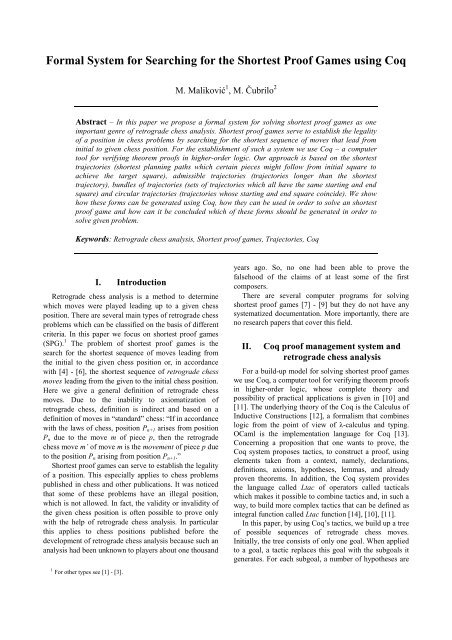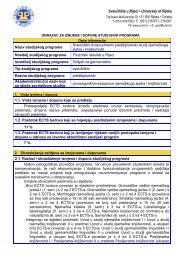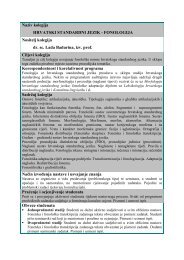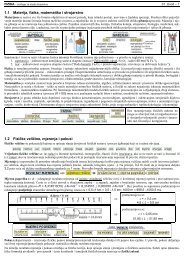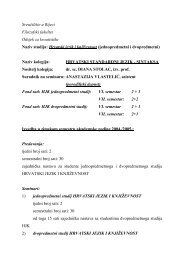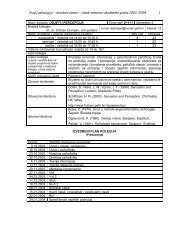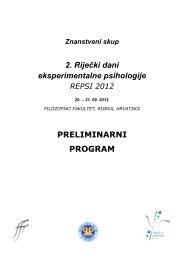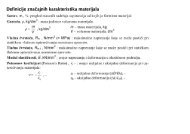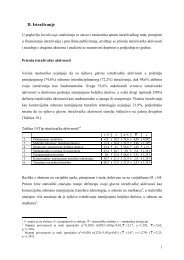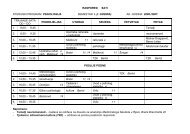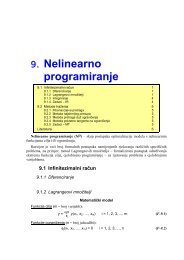Formal System for Searching for the Shortest Proof Games using Coq - Draft.pdf
Formal System for Searching for the Shortest Proof Games using Coq - Draft.pdf
Formal System for Searching for the Shortest Proof Games using Coq - Draft.pdf
You also want an ePaper? Increase the reach of your titles
YUMPU automatically turns print PDFs into web optimized ePapers that Google loves.
<strong>Formal</strong> <strong>System</strong> <strong>for</strong> <strong>Searching</strong> <strong>for</strong> <strong>the</strong> <strong>Shortest</strong> <strong>Proof</strong> <strong>Games</strong> <strong>using</strong> <strong>Coq</strong><br />
M. Maliković 1 , M. Čubrilo 2<br />
Abstract – In this paper we propose a <strong>for</strong>mal system <strong>for</strong> solving shortest proof games as one<br />
important genre of retrograde chess analysis. <strong>Shortest</strong> proof games serve to establish <strong>the</strong> legality<br />
of a position in chess problems by searching <strong>for</strong> <strong>the</strong> shortest sequence of moves that lead from<br />
initial to given chess position. For <strong>the</strong> establishment of such a system we use <strong>Coq</strong> – a computer<br />
tool <strong>for</strong> verifying <strong>the</strong>orem proofs in higher-order logic. Our approach is based on <strong>the</strong> shortest<br />
trajectories (shortest planning paths which certain pieces might follow from initial square to<br />
achieve <strong>the</strong> target square), admissible trajectories (trajectories longer than <strong>the</strong> shortest<br />
trajectory), bundles of trajectories (sets of trajectories which all have <strong>the</strong> same starting and end<br />
square) and circular trajectories (trajectories whose starting and end square coincide). We show<br />
how <strong>the</strong>se <strong>for</strong>ms can be generated <strong>using</strong> <strong>Coq</strong>, how <strong>the</strong>y can be used in order to solve an shortest<br />
proof game and how can it be concluded which of <strong>the</strong>se <strong>for</strong>ms should be generated in order to<br />
solve given problem.<br />
Keywords: Retrograde chess analysis, <strong>Shortest</strong> proof games, Trajectories, <strong>Coq</strong><br />
I. Introduction<br />
Retrograde chess analysis is a method to determine<br />
which moves were played leading up to a given chess<br />
position. There are several main types of retrograde chess<br />
problems which can be classified on <strong>the</strong> basis of different<br />
criteria. In this paper we focus on shortest proof games<br />
(SPG). 1 The problem of shortest proof games is <strong>the</strong><br />
search <strong>for</strong> <strong>the</strong> shortest sequence of moves leading from<br />
<strong>the</strong> initial to <strong>the</strong> given chess position or, in accordance<br />
with [4] - [6], <strong>the</strong> shortest sequence of retrograde chess<br />
moves leading from <strong>the</strong> given to <strong>the</strong> initial chess position.<br />
Here we give a general definition of retrograde chess<br />
moves. Due to <strong>the</strong> inability to axiomatization of<br />
retrograde chess, definition is indirect and based on a<br />
definition of moves in “standard” chess: “If in accordance<br />
with <strong>the</strong> laws of chess, position P n+1 arises from position<br />
P n due to <strong>the</strong> move m of piece p, <strong>the</strong>n <strong>the</strong> retrograde<br />
chess move m’ of move m is <strong>the</strong> movement of piece p due<br />
to <strong>the</strong> position P n arising from position P n+1 .”<br />
<strong>Shortest</strong> proof games can serve to establish <strong>the</strong> legality<br />
of a position. This especially applies to chess problems<br />
published in chess and o<strong>the</strong>r publications. It was noticed<br />
that some of <strong>the</strong>se problems have an illegal position,<br />
which is not allowed. In fact, <strong>the</strong> validity or invalidity of<br />
<strong>the</strong> given chess position is often possible to prove only<br />
with <strong>the</strong> help of retrograde chess analysis. In particular<br />
this applies to chess positions published be<strong>for</strong>e <strong>the</strong><br />
development of retrograde chess analysis because such an<br />
analysis had been unknown to players about one thousand<br />
years ago. So, no one had been able to prove <strong>the</strong><br />
falsehood of <strong>the</strong> claims of at least some of <strong>the</strong> first<br />
composers.<br />
There are several computer programs <strong>for</strong> solving<br />
shortest proof games [7] - [9] but <strong>the</strong>y do not have any<br />
systematized documentation. More importantly, <strong>the</strong>re are<br />
no research papers that cover this field.<br />
II.<br />
<strong>Coq</strong> proof management system and<br />
retrograde chess analysis<br />
For a build-up model <strong>for</strong> solving shortest proof games<br />
we use <strong>Coq</strong>, a computer tool <strong>for</strong> verifying <strong>the</strong>orem proofs<br />
in higher-order logic, whose complete <strong>the</strong>ory and<br />
possibility of practical applications is given in [10] and<br />
[11]. The underlying <strong>the</strong>ory of <strong>the</strong> <strong>Coq</strong> is <strong>the</strong> Calculus of<br />
Inductive Constructions [12], a <strong>for</strong>malism that combines<br />
logic from <strong>the</strong> point of view of λ-calculus and typing.<br />
OCaml is <strong>the</strong> implementation language <strong>for</strong> <strong>Coq</strong> [13].<br />
Concerning a proposition that one wants to prove, <strong>the</strong><br />
<strong>Coq</strong> system proposes tactics, to construct a proof, <strong>using</strong><br />
elements taken from a context, namely, declarations,<br />
definitions, axioms, hypo<strong>the</strong>ses, lemmas, and already<br />
proven <strong>the</strong>orems. In addition, <strong>the</strong> <strong>Coq</strong> system provides<br />
<strong>the</strong> language called Ltac of operators called tacticals<br />
which makes it possible to combine tactics and, in such a<br />
way, to build more complex tactics that can be defined as<br />
integral function called Ltac function [14], [10], [11].<br />
In this paper, by <strong>using</strong> <strong>Coq</strong>’s tactics, we build up a tree<br />
of possible sequences of retrograde chess moves.<br />
Initially, <strong>the</strong> tree consists of only one goal. When applied<br />
to a goal, a tactic replaces this goal with <strong>the</strong> subgoals it<br />
generates. For each subgoal, a number of hypo<strong>the</strong>ses are<br />
1 For o<strong>the</strong>r types see [1] - [3].
M. Maliković, M. Čubrilo<br />
associated that we call <strong>the</strong> local context of <strong>the</strong> subgoal. 2<br />
Each sequence of moves is stored as a hypo<strong>the</strong>sis in one<br />
subgoal, that is, each subgoal belongs to one sequence of<br />
retrograde moves. In such a way, we use <strong>Coq</strong>’s proof tree<br />
as our tree of states and actions.<br />
Why use <strong>Coq</strong> <strong>for</strong> solving retrograde chess problems?<br />
We offer a short answer by quoting from [15]: “Even<br />
most problem composers feel that <strong>the</strong> basis of retrograde<br />
chess analysis is ra<strong>the</strong>r ma<strong>the</strong>matical logic than <strong>the</strong> game<br />
of chess.”<br />
Apart from [4] - [6] and [16], so far <strong>the</strong> <strong>Coq</strong> system<br />
has not been applied in <strong>the</strong> field of chess. But, in [4] - [6]<br />
<strong>Coq</strong> is applied to different types of retrograde chess<br />
problems than <strong>the</strong> problems we deal with in this paper,<br />
and this was reason <strong>for</strong> applying different methodology<br />
<strong>for</strong> solving <strong>the</strong>se problems here. Specifically, <strong>the</strong><br />
publications mentioned deal with problems of proving<br />
invalidity of any given position, such as determining if<br />
castling is disallowed or an en passant capture is possible<br />
or determining a certain number of moves played leading<br />
up to a given position, but under <strong>the</strong> premise of <strong>the</strong><br />
lengths of <strong>the</strong> entire paths of <strong>the</strong> pieces from initial to <strong>the</strong><br />
given position being irrelevant. In [16] a <strong>for</strong>mal basis <strong>for</strong><br />
this paper is set out.<br />
III. Bases of <strong>the</strong> system<br />
After opening a new section [17], here we load <strong>the</strong> List<br />
module [17], since our model is going to use lists: 3<br />
Section SPG.<br />
Require Import List.<br />
The coordinates of <strong>the</strong> squares according to <strong>the</strong><br />
orientation of chessboard are shown in Fig. 1. As we see,<br />
<strong>the</strong> standard labels of rows and columns of <strong>the</strong><br />
chessboard are mapped into <strong>the</strong> natural numbers as<br />
follows: a→1, ..., h→8, 1→8, ..., 8→1. The set of<br />
squares on <strong>the</strong> chessboard can be defined in <strong>Coq</strong> as<br />
record type [10] with two functions column and row of<br />
type nat:<br />
Record chessboard : Set := square {column : nat; row : nat}.<br />
Set of pieces in order: king, knight, rook, bishop,<br />
queen and pawn, as well as pieces’ colors (black and<br />
white) we shall introduce as enumerated inductive types<br />
without recursion [10]:<br />
Inductive piece : Set := k | n | r | b | q | p.<br />
Inductive color : Set := W | B.<br />
2 Hereafter, if it is clear that we are talking about <strong>the</strong> local context of<br />
subgoals, we use <strong>the</strong> term "context" and not "local context".<br />
3 In this paper, we present only selected parts of <strong>the</strong> <strong>Coq</strong>'s code.<br />
Fig. 1. The coordinates of <strong>the</strong> squares<br />
IV. Trajectories<br />
The Language of Trajectories is developed in<br />
Linguistic Geometry [18], as <strong>the</strong> lowest level language of<br />
<strong>the</strong> Hierarchy of Languages [19]. In accordance with <strong>the</strong><br />
domain of this paper, we can in<strong>for</strong>mally describe<br />
trajectories as planning paths between two squares which<br />
certain pieces might follow to achieve <strong>the</strong> target square.<br />
We first want to consider shortest trajectories <strong>for</strong> an<br />
piece P of color C (abbreviation P C ) with <strong>the</strong> beginning<br />
at square (x 0 ,y 0 ) and <strong>the</strong> end at square (x n ,y n ). Trajectories<br />
will be defined as predicate whose attributes are: degree<br />
of trajectory (will be described below), piece P, color of<br />
piece C and a list of squares which represent path.<br />
The set of shortest trajectories is a subset of set of<br />
admissible trajectories of some degree which are <strong>for</strong>mally<br />
defined in [18]. We define admissible trajectories as<br />
follows (in given definition is with t P ((x m ,y m ),(x n ,y n ),l)<br />
assigned set of trajectories of piece P from (x m ,y m ) as <strong>the</strong><br />
starting square and (x n ,y n ) as end square and of length l):<br />
1. An admissible trajectory of degree 1 is a shortest<br />
trajectory;<br />
2. An admissible trajectory of degree k (k is an<br />
integer, k>1) is a trajectory tt P ((x 0 ,y 0 ),(x l ,y l ),l) if<br />
<strong>the</strong>re is a square (x i ,y i ) at chessboard such that t is<br />
a concatenation of an admissible trajectory of<br />
degree k-1 from t P ((x 0 ,y 0 ),(x i ,y i ),l 1 ) and a shortest<br />
trajectory t P ((x i ,y i ),(x l ,y l ),l 2 ), l 1 +l 2 =l.<br />
Admissible trajectories are defined inductively and<br />
<strong>the</strong>re<strong>for</strong>e we define <strong>the</strong>m in <strong>Coq</strong> as inductive predicate<br />
[10]:<br />
Inductive At : nat -> piece -> color -> list chessboard -> Prop :=<br />
Atn : <strong>for</strong>all n : nat, <strong>for</strong>all P : piece, <strong>for</strong>all C : color, <strong>for</strong>all path path1 path2 : list<br />
chessboard,<br />
At n P C path -> At n P C path1 -> At n P C path2 -><br />
nth 0 path (square 0 0) = nth 0 path1 (square 0 0) -><br />
last path1 (square 0 0) = nth 0 path2 (square 0 0) -><br />
last path2 (square 0 0) = last path (square 0 0) -><br />
At (S n) P C (app path1 path2).<br />
Note that <strong>for</strong> <strong>the</strong> starting and end square related to a<br />
piece <strong>the</strong>re is generally more than one trajectory.
M. Maliković, M. Čubrilo<br />
V. Starting state<br />
Let us consider SPG problem given at Fig. 2.<br />
Fig. 2. <strong>Shortest</strong> proof game in 8.0<br />
In SPG problems every piece has to reach its own end<br />
square. Here one problem appears: Do we know what<br />
square is an end square <strong>for</strong> every piece? Generally, in all<br />
of SPG problems we only know what <strong>the</strong> end square is<br />
<strong>for</strong> kings because <strong>the</strong> o<strong>the</strong>r pieces on <strong>the</strong> board can be<br />
promoted (except <strong>for</strong> pawns, of course, but pawns can<br />
change a column in which <strong>the</strong>y are). But, in <strong>the</strong> problem<br />
given in Fig. 2 we know what <strong>the</strong> end square <strong>for</strong> more<br />
pieces is. This is because problem given in Fig. 2 is a<br />
simplified SPG problem <strong>for</strong> several reasons. First, all<br />
pieces from <strong>the</strong> initial chess position are still on <strong>the</strong><br />
chessboard because no piece was captured and no piece<br />
was promoted in <strong>the</strong> previous moves. This means that we<br />
know what is <strong>the</strong> end square also <strong>for</strong> queens, bishops, and<br />
pawns. There are two squares that each of <strong>the</strong> knights<br />
could get to and this also applies to rooks. Moreover,<br />
some knight or rook can, in a given position, stay at <strong>the</strong><br />
end square of ano<strong>the</strong>r knight or rook of <strong>the</strong> same color<br />
and this square can be just his temporarily square. Our<br />
current intention isn’t to resolve such issues. Due to this<br />
we just discover to <strong>the</strong> reader that <strong>the</strong> knight at f6 come<br />
from square g8 and knight at c3 from b1. 4 To setup<br />
starting state of problem shown in Fig. 2, we declare<br />
predicate ON where term ON P C x 0 y 0 x n y n means that<br />
peace P C stays at square (x 0 ,y 0 ) and that square (x n ,y n ) is<br />
its target square. Then we just list all <strong>the</strong> instances of<br />
predicate ON <strong>for</strong> all pieces on <strong>the</strong> chessboard:<br />
Parameter ON : piece -> color -> nat -> nat -> nat -> nat -> Prop.<br />
Variable ON1 : ON k W 2 7 5 8.<br />
Variable ON2 : ON q W 2 8 4 8.<br />
...<br />
Variable ON32 : ON p B 8 2 8 2.<br />
4 It is clear that all rooks are at <strong>the</strong>ir side and no castling is done.<br />
VI. Metric on <strong>the</strong> chessboard<br />
In order to construct <strong>the</strong> shortest trajectories, in<br />
accordance with [18], [20] and [21], we define function<br />
MAP which gives <strong>the</strong> number of moves necessary <strong>for</strong><br />
piece P staying at (x 0 ,y 0 ) to reach square (x n ,y n ) along <strong>the</strong><br />
shortest path. For each kind of piece a different function<br />
exists, but <strong>the</strong>se functions don’t differ <strong>for</strong> <strong>the</strong> same kind<br />
of pieces of different colors apart <strong>for</strong> pawns. Let us first<br />
describe function MAP in<strong>for</strong>mally. For each kind of piece<br />
P we specify table 15×15 with number 0 on <strong>the</strong> central<br />
square of <strong>the</strong> table. The remaining squares are filled with<br />
<strong>the</strong> numbers equal to <strong>the</strong> number of moves necessary <strong>for</strong><br />
piece P to reach <strong>the</strong> given square from <strong>the</strong> central square<br />
along <strong>the</strong> shortest path or, if <strong>the</strong> square is not reachable<br />
<strong>the</strong>n with 2×<strong>the</strong> number of points in chessboard=128. To<br />
define such tables in <strong>Coq</strong> <strong>for</strong> various kinds of pieces we<br />
use function MAP_start with five initial lists of lists over<br />
natural numbers which belong to kings, knights, rooks,<br />
bishops and queens (we show here only part of function<br />
which belongs to kings):<br />
Definition MAP_start (P : piece) := match P with<br />
| k => (7 :: 7 :: 7 :: 7 :: 7 :: 7 :: 7 :: 7 :: 7 :: 7 :: 7 :: 7 :: 7 :: 7 :: 7 :: nil) ::<br />
(7 :: 6 :: 6 :: 6 :: 6 :: 6 :: 6 :: 6 :: 6 :: 6 :: 6 :: 6 :: 6 :: 6 :: 7 :: nil) ::<br />
(7 :: 6 :: 5 :: 5 :: 5 :: 5 :: 5 :: 5 :: 5 :: 5 :: 5 :: 5 :: 5 :: 6 :: 7 :: nil) ::<br />
(7 :: 6 :: 5 :: 4 :: 4 :: 4 :: 4 :: 4 :: 4 :: 4 :: 4 :: 4 :: 5 :: 6 :: 7 :: nil) ::<br />
(7 :: 6 :: 5 :: 4 :: 3 :: 3 :: 3 :: 3 :: 3 :: 3 :: 3 :: 4 :: 5 :: 6 :: 7 :: nil) ::<br />
(7 :: 6 ::-5 :: 4 :: 3 :: 2 :: 2 :: 2 :: 2 :: 2-:: 3 :: 4 :: 5 :: 6 :: 7 :: nil) ::<br />
(7 :: 6 ::-5 :: 4 :: 3 :: 2 :: 1 :: 1 :: 1 :: 2-:: 3 :: 4 :: 5 :: 6 :: 7 :: nil) ::<br />
(7 :: 6 ::-5 :: 4 :: 3 :: 2 :: 1 :: 0 :: 1 :: 2-:: 3 :: 4 :: 5 :: 6 :: 7 :: nil) ::<br />
(7 :: 6 ::-5 :: 4 :: 3 :: 2 :: 1 :: 1 :: 1 :: 2-:: 3 :: 4 :: 5 :: 6 :: 7 :: nil) ::<br />
(7 :: 6 ::-5 :: 4 :: 3 :: 2 :: 2 :: 2 :: 2 :: 2-:: 3 :: 4 :: 5 :: 6 :: 7 :: nil) ::<br />
(7 :: 6 ::-5 :: 4 :: 3 :: 3 :: 3 :: 3 :: 3 :: 3-:: 3 :: 4 :: 5 :: 6 :: 7 :: nil) ::<br />
(7 :: 6 ::-5 :: 4 :: 4 :: 4 :: 4 :: 4 :: 4 :: 4-:: 4 :: 4 :: 5 :: 6 :: 7 :: nil) ::<br />
(7 :: 6 ::-5 :: 5 :: 5 :: 5 :: 5 :: 5 :: 5 :: 5-:: 5 :: 5 :: 5 :: 6 :: 7 :: nil) ::<br />
(7 :: 6 :: 6 :: 6 :: 6 :: 6 :: 6 :: 6 :: 6 :: 6 :: 6 :: 6 :: 6 :: 6 :: 7 :: nil) ::<br />
(7 :: 7 :: 7 :: 7 :: 7 :: 7 :: 7 :: 7 :: 7 :: 7 :: 7 :: 7 :: 7 :: 7 :: 7 :: nil) ::<br />
nil<br />
...<br />
The required results of function MAP <strong>for</strong> <strong>the</strong> king<br />
standing at f6 is represented by a 8×8 sub-table (internal<br />
shaded table) in which number 0 is located in <strong>the</strong> square<br />
where observed piece stands. 5<br />
To define function MAP over function MAP_start we<br />
first define several auxiliary recursive functions [22],<br />
[11], [10].<br />
Fixpoint beginning_of_linear_list (x0 : nat) (l : list nat) {struct l} : list nat :=<br />
match l with<br />
nil => nil<br />
| l'::l1 => match 16-x0 with<br />
0 => nil<br />
| S x0' => l'::beginning_of_linear_list (x0+1) l1<br />
end<br />
end.<br />
5 Now we can see that asymmetry is not only <strong>the</strong> reason <strong>for</strong> <strong>the</strong><br />
problem of creating lists <strong>for</strong> pawns. The situation is fur<strong>the</strong>r<br />
complicated because of <strong>the</strong> following: <strong>the</strong> impossibility of pawns<br />
standing in <strong>the</strong> 1 st and 8 th rows, because of <strong>the</strong> move two squares<br />
backward only from <strong>the</strong> 4 th row (<strong>for</strong> white) or from <strong>the</strong> 5 th row (<strong>for</strong><br />
black) and because of diagonal moves (retrograde capturing).
M. Maliković, M. Čubrilo<br />
Fixpoint rest_of_linear_list (x0 : nat) (l : list nat) {struct l} : list nat :=<br />
match l with<br />
nil => nil<br />
| l'::l1 => match 8-x0 with<br />
0 => l<br />
| S x0' => rest_of_linear_list (x0+1) l1<br />
end<br />
end.<br />
Fixpoint beginning_of_2_dim_list (y0 : nat) (l : list (list nat)) {struct l} : list (list<br />
nat) :=<br />
match l with<br />
nil => nil<br />
| l'::l1 => match 16-y0 with<br />
0 => nil<br />
| S y0' => l'::beginning_of_2_dim_list (y0+1) l1<br />
end<br />
end.<br />
Fixpoint rest_of_2_dim_list (y0 : nat) (l : list (list nat)) {struct l} : list (list nat) :=<br />
match l with<br />
nil => nil<br />
| l' :: l1 => match 8-y0 with<br />
0 => l<br />
| S y0' => rest_of_2_dim_list (y0+1) l1<br />
end<br />
end.<br />
Fixpoint MAP_temp (x0 y0 : nat) (l : list (list nat)) {struct l} : list (list nat) :=<br />
match l with<br />
nil => nil<br />
| l' :: l1 => app (0 :: nil) (rest_of_linear_list x0 (beginning_of_linear_list x0 l'))<br />
:: MAP_temp x0 y0 l1<br />
end.<br />
The attributes of function MAP are <strong>the</strong> coordinates of<br />
<strong>the</strong> starting square of piece P and starting 15×15 table<br />
which belong to pieces of <strong>the</strong> type P:<br />
Definition MAP x0 y0 l := app ((0 :: nil) :: nil) (MAP_temp x0 y0<br />
(rest_of_2_dim_list y0 (beginning_of_2_dim_list y0 l))).<br />
VII. Generating shortest trajectories<br />
In this section we show how in <strong>Coq</strong> all shortest<br />
trajectories <strong>for</strong> piece P from (x 0 ,y 0 ) to (x n ,y n ) can be<br />
iteratively generated, mostly in accordance with <strong>the</strong> steps<br />
given in [18].<br />
For example, in <strong>the</strong> position shown at Fig. 3 we have<br />
to find all <strong>the</strong> shortest trajectories <strong>for</strong> <strong>the</strong> white king from<br />
c7=(3,2) to his target square e1=(5,8).<br />
First we compute <strong>the</strong> shortest distance l 0 between <strong>the</strong><br />
starting and end square by computing MAP <strong>for</strong> given<br />
starting square (x 0 ,y 0 ) and given piece. In our example we<br />
have to compute MAP 3 2 (MAP_start k). The value in<br />
<strong>the</strong> resulting list which corresponds to <strong>the</strong> end square is<br />
<strong>the</strong> shortest distance l 0 (in our example l 0 =6). Fur<strong>the</strong>r, we<br />
compute MAP <strong>for</strong> end square (x n ,y n ) and same piece (in<br />
our example MAP 5 8 (MAP_start k)). Now, we find <strong>the</strong><br />
set of squares such as MAP x 0 y 0 (MAP_start k) + MAP<br />
x n y n (MAP_start k) = l 0 . To find this set which we denote<br />
by SUM, we define function Sum which is <strong>the</strong> sum of two<br />
2-dimensional matrices:<br />
Fixpoint Sum_linear (M1 M2 : list nat) {struct M1} : list nat :=<br />
match M1 with<br />
nil => nil<br />
| M :: M1' => match M2 with<br />
nil => nil<br />
| N :: M2' => nth 0 M1 0 + nth 0 M2 0 :: Sum_linear M1' M2'<br />
end<br />
end.<br />
Fixpoint Sum (M1 M2 : list (list nat)) {struct M1} : list (list nat) :=<br />
match M1 with<br />
nil => nil<br />
| M :: M1' => match M2 with<br />
nil => nil<br />
| N :: M2' => Sum_linear M N :: Sum M1' M2'<br />
end<br />
end.<br />
After computing SUM we get:<br />
Sum (MAP 3 2 (MAP_start k)) (MAP 5 8 MAP_start k)) =<br />
(0 :: nil) ::<br />
(0 :: 9 :: 8 :: 8 :: 8 :: 9 :: 10 :: 11 :: 12 :: nil) ::<br />
(0 :: 8 :: 7 :: 6 :: 7 :: 8 :: 9 :: 10 :: 11 :: nil) ::<br />
(0 :: 7 :: 6 :: 6 :: 6 :: 7 :: 8 :: 9 :: 10 :: nil) ::<br />
(0 :: 6 :: 6 :: 6 :: 6 :: 6 :: 7 :: 8 :: 9 :: nil) ::<br />
(0 :: 7 :: 6 :: 6 :: 6 :: 6 :: 6 :: 7 :: 8 :: nil) ::<br />
(0 :: 8 :: 7 :: 6 :: 6 :: 6 :: 6 :: 6 :: 8 :: nil) ::<br />
(0 :: 9 :: 8 :: 7 :: 6 :: 6 :: 6 :: 7 :: 8 :: nil) ::<br />
(0 :: 10 :: 9 :: 8 :: 7 :: 6 :: 7 :: 8 :: 9 :: nil) :: nil<br />
All <strong>the</strong> first possible moves from <strong>the</strong> starting square<br />
are from <strong>the</strong> intersection of three sets:<br />
• SUM<br />
• ST 1 (x 0 ,y 0 )={square x y | nth x (nth y (MAP x 0 y 0<br />
(MAP_start k)) nil) 0=1}<br />
• ST l0-l+1(x l0-l+1,y l0-l+1)={square x y | nth x (nth y<br />
(MAP x l0-l+1 y l0-l+1 (MAP_start k)) nil) 0=l 0 -l+1}<br />
<strong>for</strong> l=l 0<br />
Fig. 3. By which shortest paths can white king from c7=(3,2) come to<br />
his target square e1=(5,8)?<br />
For example, in <strong>the</strong> case shown in Fig. 3, b6, c6 and<br />
d6 are three end squares of all <strong>the</strong> possible first moves<br />
from c7 related to e1. These squares are now new starting<br />
squares <strong>for</strong> <strong>the</strong> next step of generation. The SUM is <strong>the</strong>
M. Maliković, M. Čubrilo<br />
same <strong>for</strong> all steps of <strong>the</strong> generation, while ST 1 and ST l0-l+1<br />
iterative changed in <strong>the</strong> way that ST 1 in every next step as<br />
arguments takes coordinates of <strong>the</strong> new square, while in<br />
ST l0-l+1 in every next step value l decreases by one. In<br />
such a way, after l 0 steps we get all <strong>the</strong> possible shortest<br />
trajectories as described in <strong>the</strong> next section.<br />
VIII. Bundles of trajectories<br />
Bundle of trajectories of some degree and <strong>for</strong> some<br />
piece, in accordance with [18], is a set of trajectories<br />
which all have <strong>the</strong> same starting and end square:<br />
Parameter bt : nat -> piece -> color -> nat -> nat -> nat -> nat -> list (list<br />
chessboard).<br />
To iteratively generate bundles of shortest trajectories<br />
<strong>for</strong> all pieces on <strong>the</strong> chessboard we create very complex<br />
auxiliary function GM, function GBT1 and main<br />
recursive function GBT:<br />
Fixpoint GM (i : nat) (j : nat) (n : nat) (P : piece) (C : color) (t0 : list chessboard)<br />
(xl yl : nat) {struct n} : list (list chessboard) :=<br />
match n with<br />
S n' => match j with<br />
S j' => match i with<br />
S i' => if eq_nat (nth i (nth j (MAP (column (last t0 (square 0 0))) (row<br />
(last t0 (square 0 0))) (MAP_start P)) nil) 0) 1<br />
<strong>the</strong>n if eq_nat (nth i (nth j (MAP (column (nth 0 t0 (square 0 0))) (row<br />
(nth 0 t0 (square 0 0))) (MAP_start P)) nil) 0) (length t0)<br />
<strong>the</strong>n if eq_nat (nth i (nth j ((Sum (MAP (column (nth 0 t0 (square 0 0)))<br />
(row (nth 0 t0 (square 0 0))) (MAP_start P)) (MAP xl yl (MAP_start P)))) nil) 0)<br />
(nth xl (nth yl (MAP (column (nth 0 t0 (square 0 0))) (row (nth 0 t0 (square 0<br />
0))) (MAP_start P)) nil) 0)<br />
<strong>the</strong>n if eq_nat i xl<br />
<strong>the</strong>n if eq_nat j yl<br />
<strong>the</strong>n (app t0 (square i j :: nil)) :: nil<br />
else app (GM i' j n' P C t0 xl yl) ((app t0 (square i j :: nil)) :: nil)<br />
else app (GM i' j n' P C t0 xl yl) ((app t0 (square i j :: nil)) :: nil)<br />
else GM i' j n' P C t0 xl yl<br />
else GM i' j n' P C t0 xl yl<br />
else GM i' j n' P C t0 xl yl<br />
| _ => GM 8 j' n' P C t0 xl yl<br />
end<br />
| _ => if eq_nat xl (column (nth 0 t0 (square 0 0))) <strong>the</strong>n if eq_nat yl (row<br />
(nth 0 t0 (square 0 0))) <strong>the</strong>n (t0 :: nil) else nil else nil<br />
end<br />
| _ => nil<br />
end.<br />
Fixpoint GBT1 (P : piece) (C : color) (bt : list (list chessboard)) (xl yl : nat)<br />
{struct bt} :=<br />
match bt with<br />
nil => nil<br />
| bt0 :: bt' => app (GM 8 8 128 P C bt0 xl yl) (GBT1 P C bt' xl yl)<br />
end.<br />
Fixpoint GBT (P : piece) (C : color) (bt : list (list chessboard)) (xl yl n : nat)<br />
{struct n} :=<br />
match n with<br />
| O => bt<br />
| S n' => GBT1 P C (GBT P C bt xl yl n') xl yl<br />
end.<br />
Now we introduce axiom AGBT which will allow us to<br />
compute a bundle of shortest trajectories as result of <strong>the</strong><br />
function GBT:<br />
Axiom AGBT : <strong>for</strong>all x0 y0 xl yl k : nat, <strong>for</strong>all P : piece, <strong>for</strong>all C : color,<br />
ON P C x0 y0 xl yl -><br />
bt k P C x0 y0 xl yl (GBT P C ((square x0 y0 :: nil) :: nil) xl yl (nth xl (nth yl (MAP<br />
x0 y0 (MAP_start P)) nil) 0)).<br />
We can create <strong>the</strong> Ltac function LGBST which will<br />
from hypo<strong>the</strong>ses in <strong>the</strong> initial state of system generate<br />
bundles of shortest trajectories <strong>for</strong> all pieces <strong>for</strong> which<br />
trajectories exist:<br />
Ltac LGBST :=<br />
repeat<br />
match goal with<br />
[h : ON ?P ?C ?X0 ?Y0 ?XL ?YL |- _ ] =><br />
apply AGBT with (k:=1) in h;compute in h<br />
end.<br />
The resulting bundles will appear in context as lists of<br />
lists of squares. For example, bundle of shortest<br />
trajectories of <strong>the</strong> white king in problem given at Fig. 2<br />
will look like this:<br />
bt 1 k W 2 7 5 8 ((square 2 7 :: square 3 6 :: square 4 7 :: square 5 8 :: nil) ::<br />
(square 2 7 :: square 3 7 :: square 4 7 :: square 5 8 :: nil) :: (square 2 7 ::<br />
square 3 7 :: square 4 8 :: square 5 8 :: nil) :: (square 2 7 :: square 3 8 :: square<br />
4 7 :: square 5 8 :: nil) :: (square 2 7 :: square 3 8 :: square 4 8 :: square 5 8 ::<br />
nil) :: nil)<br />
To generate single trajectories from such bundles we<br />
need one new recursive function FGT, axiom AGT and<br />
Ltac function LAGT as follows:<br />
Fixpoint FGT (P : piece) (C : color) (bt : list (list chessboard)) {struct bt} : Prop<br />
:=<br />
match bt with<br />
nil => True<br />
| bt0 :: bt' => At 1 P C bt0 /\ (FGT P C bt')<br />
end.<br />
Axiom AGT : <strong>for</strong>all k x0 y0 xl yl : nat, <strong>for</strong>all P : piece, <strong>for</strong>all C : color, <strong>for</strong>all bt_list<br />
: list (list chessboard),<br />
bt k P C x0 y0 xl yl bt_list -> FGT P C bt_list.<br />
Ltac LAGT :=<br />
repeat<br />
match goal with<br />
[h : _ |- _ ] => apply AGT in h;compute in h<br />
end;<br />
repeat<br />
match goal with<br />
[h : (_ /\ _) |- _ ] => case h;clear h;intros<br />
end;<br />
repeat<br />
match goal with<br />
[h : True |- _ ] => clear h<br />
end.<br />
Function FTC takes as its argument <strong>the</strong> bundle of<br />
trajectories, and as a result produces a conjunction of
M. Maliković, M. Čubrilo<br />
claims that every element of <strong>the</strong> bundle is a trajectory.<br />
AGT axiom asserts that <strong>the</strong> existence of a bundle of<br />
trajectories entails <strong>the</strong> existence of a conjunction of<br />
assertions about <strong>the</strong> existence of individual trajectories or<br />
<strong>the</strong> existence of <strong>the</strong> result of <strong>the</strong> function FTC. Finally,<br />
Ltac function LAGT generates single trajectories from<br />
bundles <strong>using</strong> <strong>the</strong> above function and axiom.<br />
IX. Obstacles<br />
In retrograde chess analysis a piece P can’t reach some<br />
square (blocked destination) if it is occupied by ano<strong>the</strong>r<br />
element P’ and can’t cross <strong>the</strong> square (blocked beam) if it<br />
is occupied by ano<strong>the</strong>r element P’ although P and P’ can<br />
belong to <strong>the</strong> same or <strong>the</strong> opponents side. Blocked<br />
destinations and blocked beams are called obstacles. In<br />
some positions two kinds of obstacles can exist <strong>for</strong> pieces<br />
to reach a square: unmovable and movable. Unmovable<br />
obstacles are pieces which stay at <strong>the</strong>ir target square and<br />
can’t move anymore. Such obstacles have to be bypassed.<br />
In <strong>the</strong> context we get after applying <strong>the</strong> function<br />
LAGT, some trajectories can be of length 1. Those<br />
trajectories correspond to unmovable obstacles. We<br />
introduce type At_block, axiom A_block and Ltac<br />
function L_block_end_square by whose application we<br />
can assign all trajectories of length 1 as unmovable<br />
obstacles:<br />
Parameter At_block : piece -> color -> list chessboard -> Prop.<br />
Axiom A_block : <strong>for</strong>all P : piece, <strong>for</strong>all C : color, <strong>for</strong>all x y : nat,<br />
At 1 P C (square x y :: nil) -> At_block P C (square x y :: nil).<br />
Ltac L_block_end_square :=<br />
repeat<br />
match goal with<br />
[h : At ?k ?P ?C (square ?X ?Y :: nil) |- _] => apply A_block in h<br />
end.<br />
Movable obstacles are pieces that can still move and<br />
o<strong>the</strong>r pieces can wait <strong>the</strong>ir move. In order to consider<br />
movable and unmovable obstacles we create a new<br />
important function: function obstacle whose result will<br />
indicate whe<strong>the</strong>r a piece obstructs ano<strong>the</strong>r piece to reach<br />
<strong>the</strong> planned square. The term obstacle x y x 1 y 1 x 2 y 2 will<br />
return <strong>the</strong> boolean value true if square (x,y) is <strong>the</strong><br />
obstacle <strong>for</strong> <strong>the</strong> move of a piece from square (x 1 ,y 1 ) to<br />
square (x 2 ,y 2 ) and <strong>the</strong> value false o<strong>the</strong>rwise. The function<br />
obstacle is based on a comparison of <strong>the</strong> coordinates of<br />
<strong>the</strong> considered squares which we will not show here.<br />
X. Impossible trajectories<br />
All trajectories which contain a move with an<br />
unmovable obstacle have to be eliminated from<br />
consideration and we call <strong>the</strong>se trajectories impossible<br />
trajectories. To find and eliminate impossible trajectories<br />
we create <strong>the</strong> recursive function F_s_on_t, axiom<br />
A_block_t and Ltac function L_Block_t. The term<br />
F_s_on_t x y P C l with <strong>the</strong> help of function obstacle<br />
gives as a result <strong>the</strong> boolean value of true if at <strong>the</strong> square<br />
(x,y) an unmovable obstacle <strong>for</strong> <strong>the</strong> trajectory l of <strong>the</strong><br />
piece P C is to be found. Also, axiom A_block_t claims<br />
that if some unmovable obstacle is blocking a trajectory<br />
<strong>the</strong>n this trajectory corresponds to <strong>the</strong> blocked trajectory<br />
at its starting square while Ltac function L_Block_t<br />
provides <strong>the</strong> elimination of <strong>the</strong> trajectory if <strong>the</strong> conditions<br />
are satisfied:<br />
Fixpoint F_s_on_t (x y:nat) (P:piece) (C:color) (l:list chessboard) {struct l} : bool<br />
:=<br />
match l with<br />
nil => false<br />
| l' :: l1 => match l1 with<br />
nil => false<br />
| _ => match obstacle x y (column l') (row l') (column (nth 0 l1<br />
(square 0 0))) (row (nth 0 l1 (square 0 0))) with<br />
true => true<br />
| false => F_s_on_t x y P C l1<br />
end<br />
end<br />
end.<br />
Axiom A_block_t : <strong>for</strong>all P :<br />
piece, <strong>for</strong>all C : color, <strong>for</strong>all t : list chessboard, <strong>for</strong>all k x y : nat,<br />
At k P C t -><br />
F_s_on_t x y P C t = true -><br />
At_block P C (nth 0 t (square 0 0) :: nil).<br />
Ltac L_Block_t :=<br />
repeat<br />
match goal with<br />
[h1 : At 1 ?P1 ?C1 (square ?X1 ?Y1 :: ?t1), h2 : At_block ?P2 ?C2 (square<br />
?X2 ?Y2 :: nil) |- _ ] => apply A_block_t with (P:=P1) (C:=C1) (t:=square X1 Y1<br />
:: t1) (x:=X2) (y:=Y2) in h1;[compute in h1;match goal with [h3 : At 1 P1 C1<br />
(square X1 Y1 :: ?t2) |- _ ] => clear h1 | [ |- _ ] => rewrite A_no_solution; tauto<br />
end | tauto]<br />
end.<br />
In addition, function L_Block_t does <strong>the</strong>se steps:<br />
1. If in <strong>the</strong> context more than one trajectories with<br />
<strong>the</strong> same starting square appears and if one of<br />
<strong>the</strong>m is blocked by a piece, <strong>the</strong>n this trajectory can<br />
be cleared from <strong>the</strong> context (this step is iteratively<br />
repeated);<br />
2. If after step 1 in <strong>the</strong> context only one trajectory<br />
from a starting square remains and if this<br />
trajectory is blocked by an unmovable obstacle<br />
<strong>the</strong>n <strong>the</strong> observed subgoal contains no solution to<br />
<strong>the</strong> problem and will be eliminated from<br />
consideration;<br />
3. Clearing double trajectories which can occur in<br />
<strong>the</strong> context of a subgoal, because more blocked<br />
trajectories of <strong>the</strong> same piece can corresponds to<br />
<strong>the</strong> blocked trajectory at its starting square.
M. Maliković, M. Čubrilo<br />
XI. Generating shortest proof games<br />
To solve a shortest proof game means to find <strong>the</strong><br />
shortest sequence of alternating white and black moves<br />
leading from <strong>the</strong> initial to a given chess position.<br />
Generally, one move is given by <strong>the</strong> kind of piece it is, its<br />
color and <strong>the</strong> starting and end squares. For <strong>the</strong> purposes<br />
of this paper, in <strong>the</strong> declaration of a move we have to add<br />
<strong>the</strong> attribute of type nat which indicates <strong>the</strong> ordinal<br />
number of moves in <strong>the</strong> shortest proof game:<br />
Parameter move : nat -> piece -> color -> chessboard -> chessboard -> Prop.<br />
With <strong>the</strong> help of <strong>the</strong> shortest trajectories we can<br />
minimize <strong>the</strong> number of obvious moves in shortest proof<br />
game. We can see that after <strong>the</strong> elimination of impossible<br />
trajectories from context of problem given at Fig. 2, <strong>the</strong><br />
sum of number of moves in trajectories is equal to 16<br />
provided that we take into account one trajectory <strong>for</strong><br />
every piece. This is in accordance with <strong>the</strong> assumption of<br />
problem which is given as “<strong>Shortest</strong> proof game in 8.0”.<br />
Now we have, in <strong>the</strong> correct order, to add up <strong>the</strong> moves<br />
from <strong>the</strong> remaining trajectories in context. If At 1 P C<br />
(square x1 y1 :: square x2 y2 :: l :: nil) is an trajectory of<br />
degree 1 <strong>for</strong> some piece P C with first move from (x 1 ,y 1 ) to<br />
(x 2 ,y 2 ) and with l as rest of <strong>the</strong> path, <strong>the</strong>n, if we want to<br />
add hypo<strong>the</strong>sis move i P C (square x1 y1) (square x2 y2)<br />
to <strong>the</strong> context, <strong>the</strong> considered trajectory has to be reduced<br />
<strong>for</strong> its first square. This can be <strong>for</strong>mally introduced in our<br />
system as <strong>the</strong> following axiom:<br />
Axiom AGSPG : <strong>for</strong>all P : piece, <strong>for</strong>all C : color, <strong>for</strong>all x1 y1 x2 y2 i k : nat, <strong>for</strong>all<br />
l : list chessboard,<br />
At k P C (square x1 y1 :: square x2 y2 :: l) -><br />
At k P C (square x2 y2 :: l) /\ move i P C (square x1 y1) (square x2 y2).<br />
We now need to generate as many hypo<strong>the</strong>ses about<br />
<strong>the</strong> possible first moves as <strong>the</strong>re are possible moves <strong>for</strong> a<br />
player whose turn it is. For now, <strong>the</strong> moves have to<br />
satisfy <strong>the</strong> conditions not to skip any piece and not to<br />
arrive at a square occupied by ano<strong>the</strong>r piece. So, we need<br />
<strong>the</strong> following axiom by which those moves that do not<br />
meet <strong>the</strong>se conditions can be eliminated:<br />
Axiom Move_Obstacle : <strong>for</strong>all P1 P2 : piece, <strong>for</strong>all C1 C2 : color, <strong>for</strong>all x y x1 y1<br />
x2 y2 i k : nat, <strong>for</strong>all l : list chessboard,<br />
move i P1 C1 (square x1 y1) (square x2 y2) -><br />
At k P2 C2 (square x y :: l) /\ obstacle x y x1 y1 x2 y2 = true -><br />
False.<br />
As is mentioned in <strong>the</strong> section II of this paper, each of<br />
<strong>the</strong> possible moves will be generated in a separate<br />
subgoal. From all of <strong>the</strong>se subgoals we will generate new<br />
subgoals which will contain second moves which belong<br />
to <strong>the</strong> opponent. And so we continue to build a tree until<br />
we generate one subgoal which will contain <strong>the</strong> solution.<br />
For this purpose we create <strong>the</strong> following Ltac function<br />
LGSPG with <strong>the</strong> attributes col which indicates a players’<br />
color whose turn it is and attribute i which indicates what<br />
<strong>the</strong> ordinal number of moves is:<br />
Ltac LGSPG col I :=<br />
assert (H_goal : no_solution);<br />
[match goal with<br />
[h : At 1 ?P col (square ?X1 ?Y1 :: square ?X2 ?Y2 :: ?l) |- _ ] => apply<br />
AGSPG with (i:=I) in h;case h;clear h;intro h;pattern 1 in h;intro<br />
end<br />
|<br />
match goal with<br />
[h : At 1 ?P col (square ?X1 ?Y1 :: square ?X2 ?Y2 :: ?l) |- _ ] => pattern 1 in h<br />
end];<br />
repeat<br />
match goal with<br />
[H_goal : no_solution |- _ ] => clear H_goal; assert (H_goal : no_solution);<br />
[match goal with<br />
[h : At 1 ?P col (square ?X1 ?Y1 :: square ?X2 ?Y2 :: ?l) |- _ ] => apply<br />
AGSPG with (i:=I) in h;case h;clear h;intro h;pattern 1 in h;intro<br />
end<br />
|<br />
match goal with<br />
[h : At 1 ?P col (square ?X1 ?Y1 :: square ?X2 ?Y2 :: ?l) |- _ ] => pattern 1 in h<br />
end]<br />
end;<br />
try assumption;<br />
simpl in * |-;<br />
try<br />
match goal with<br />
[h1 : move I ?p1 ?c1 (square ?X1 ?Y1) (square ?X2 ?Y2), h2 : At 1 ?p2 ?c2<br />
(square ?X2 ?Y2 :: ?L2), h3 : At 1 ?p3 ?c3 (square ?X ?Y :: ?L) |- _ ] => apply<br />
Move_Obstacle with (P2:=p3) (C2:=c3) (x:=X) (y:=Y) (l:=L) in h1;[tauto |<br />
(split;[assumption | tauto])]<br />
end;<br />
match goal with<br />
[h1 : move I ?P col (square ?x1 ?y1) (square ?x2 ?y2) |- _] =><br />
repeat<br />
match goal with<br />
[h2 : At 1 P col (square x1 y1 :: ?l2) |- _] => clear h2<br />
end<br />
end.<br />
Note that at <strong>the</strong> end of <strong>the</strong> function LGSPG we clear<br />
trajectories that are no longer valid because <strong>the</strong> same<br />
piece has already made a move on ano<strong>the</strong>r trajectory.<br />
Whilst generating shortest proof game and reducing<br />
trajectories, new trajectories of length 1, which represent<br />
unmovable obstacles can appear in <strong>the</strong> context of new<br />
subgoals. Due to this, we have to try to use <strong>the</strong> function<br />
L_block_end_square again. After this it can occur that<br />
new blocked trajectories appear in context and <strong>the</strong>y have<br />
to be eliminated from consideration by applying function<br />
L_Block_t. Now we have to find all <strong>the</strong> possible moves of<br />
<strong>the</strong> player whose turn it is and so on. In this way our<br />
system gives us a unique solution of <strong>the</strong> problem given at<br />
Fig. 2, and this solution is: 1. b3 d6 2. Bb2 Nd7 3. Bd4<br />
Nf6 4. Nc3 Qd7 5. Qb1 Kd8 6. Kd1 Ne8 7. Kc1 Nf6 8.<br />
Kb2 Rg8.
M. Maliković, M. Čubrilo<br />
XII. Admissible trajectories<br />
Let us now consider problem showed in Fig. 4. The<br />
number of moves in this shortest proof game is not given<br />
in advance. Due to this we don’t know who made <strong>the</strong> last<br />
move. If we count all obvious white and black moves we<br />
get number 6 <strong>for</strong> both players.<br />
In both cases it is necessary to replace <strong>the</strong> existing<br />
trajectory of degree k of <strong>the</strong> blocked piece with a bundle<br />
of trajectories of degree higher than k.<br />
In <strong>the</strong> case of <strong>the</strong> problem as given in Fig. 4, <strong>the</strong><br />
system gives us <strong>the</strong> answer that in different scenarios two<br />
pieces become blocked: white bishop at c7 and black<br />
bishop at c2. The number of moves has to extend from 12<br />
to 13 and it means that white played one move more than<br />
black. Due to this we have to generate an admissible<br />
trajectory of degree 2 <strong>for</strong> <strong>the</strong> white bishop. To<br />
accomplish this, first we have to generate bundles of<br />
admissible trajectories of degree 2.<br />
Fig. 4. Markus Ott, feenschach 1982, <strong>Shortest</strong> proof game?<br />
So, we can conclude that <strong>the</strong> last move was made by<br />
black and that shortest proof game is 12 moves long. If<br />
we try to solve <strong>the</strong> problem under <strong>the</strong>se conditions and in<br />
<strong>the</strong> way described in previous sections, system finds a<br />
sequence of 9 moves as <strong>the</strong> longest sequence. A longer<br />
sequence doesn’t exist because in all cases a piece<br />
remains blocked. So, something with our assumptions is<br />
wrong. First, <strong>the</strong> black did not make <strong>the</strong> last move since it<br />
<strong>the</strong>re would have to exist a shortest proof game with at<br />
least 12 moves long. This means that white made <strong>the</strong> last<br />
move. From this, it arises that shortest proof game is<br />
longer than 12 moves, at least because <strong>the</strong> number of<br />
moves must be odd. This means that <strong>the</strong> trajectory of at<br />
least one piece is longer than <strong>the</strong> shortest trajectory.<br />
Problem given at Fig. 4 has to be solved by<br />
constructing admissible trajectories of some degree k>1.<br />
First we have to try to solve problem given at Fig. 4 by<br />
generating at least one trajectory of degree 2. By<br />
definition, every admissible trajectory t of degree 2 can<br />
be generated by two shortest trajectories t 1 and t 2 where<br />
<strong>the</strong> end square of t 1 and starting square of t 2 correspond<br />
to each o<strong>the</strong>r and this square is called dock. So, we have<br />
to find one dock <strong>for</strong> trajectory <strong>for</strong> which we have to find<br />
an admissible trajectory of degree 2. The first question<br />
that arises is <strong>for</strong> what piece do we have to generate an<br />
admissible trajectory. To find out, we changed our system<br />
so that as a result we offer an answer to <strong>the</strong> question of<br />
which pieces remain blocked when we try to solve <strong>the</strong><br />
problem <strong>using</strong> only <strong>the</strong> shortest trajectories. Such a<br />
modified system will assign <strong>the</strong> pieces that are blocked in<br />
two different ways:<br />
1. The piece is blocked by an unmovable obstacle<br />
2. The piece is blocked by a movable obstacle<br />
Fig. 5. Generating a bundle of trajectories of degree k+1 from <strong>the</strong><br />
bundle of trajectories of degree k<br />
It can be shown that it is very useful to find all docks<br />
first, that is in our example, all squares (x D ,y D ) <strong>for</strong> which
M. Maliković, M. Čubrilo<br />
MAP 3 2 (MAP_start b) + MAP 3 8 (MAP_start b) = 3.<br />
After that we have to generate <strong>for</strong> every dock (x D ,y D ) a<br />
bundle of shortest trajectories from (x 0 ,y 0 ) to (x D ,y D ) and a<br />
bundle of shortest trajectories from (x D ,y D ) to (x n ,y n ). Fig.<br />
5 shows how to generate bundle of trajectories of degree<br />
k+1 from <strong>the</strong> bundle of trajectories of degree k.<br />
Finally, we have to merge two obtained bundles of<br />
trajectories as combinations of every trajectory from <strong>the</strong><br />
first bundle with every trajectory from <strong>the</strong> second bundle.<br />
So, if p admissible trajectories of degree k and q<br />
corresponding shortest trajectories is generated, <strong>the</strong>n p×q<br />
admissible trajectories of degree k+1 will be obtained.<br />
There<strong>for</strong>e, we define <strong>the</strong> recursive function which makes<br />
such combinations and combines all trajectories into a<br />
single bundle:<br />
Fixpoint Add_bundles (b1 b2 : list (list chessboard)) (i j n : nat) {struct n} : list<br />
(list chessboard) :=<br />
match n with<br />
S n' => match i with<br />
S i' => match j with<br />
S j' => (app (nth (i-1) b1 (square 0 0 :: nil))<br />
(nth (j-1) b2 (square 0 0 :: nil))) ::<br />
(Add_bundles b1 b2 i j' n')<br />
| _ => Add_bundles b1 b2 i' (length b2) n'<br />
end<br />
| _ => nil<br />
end<br />
| _ => nil<br />
end.<br />
Specifically, <strong>for</strong> <strong>the</strong> white bishop in <strong>the</strong> problem given<br />
in Fig. 4 we generate <strong>the</strong>se five admissible trajectories of<br />
degree 2:<br />
At 2 b W (square 3 2 :: square 4 1 :: square 7 4 :: square 3 8 :: nil)<br />
At 2 b W (square 3 2 :: square 2 3 :: square 5 6 :: square 3 8 :: nil)<br />
At 2 b W (square 3 2 :: square 4 3 :: square 1 6 :: square 3 8 :: nil)<br />
At 2 b W (square 3 2 :: square 1 4 :: square 4 7 :: square 3 8 :: nil)<br />
At 2 b W (square 3 2 :: square 5 4 :: square 2 7 :: square 3 8 :: nil)<br />
Note that we avoid <strong>the</strong> generation of trajectories where<br />
<strong>the</strong> piece runs twice across <strong>the</strong> same squares and<br />
trajectories in which <strong>the</strong> “straight path” is divided into<br />
two parts.<br />
After generating <strong>the</strong> above trajectories we can proceed<br />
to solve <strong>the</strong> problem in a manner analogous to <strong>the</strong><br />
methods proposed in <strong>the</strong> previous sections. The system<br />
gives us this solution: 1. c4 d6 2. Qb3 Bf5 3. Qb4 Bc2 4.<br />
d3 Qd7 5. Be3 Qb5 6. Bb6 c5 7. Bc7.<br />
Note that <strong>for</strong> solving problem showed at Fig. 4 we<br />
have to introduce one more rule and that is: “After some<br />
retrograde moves, <strong>the</strong> opponent’s king may not be in<br />
check”. Detailed analysis and <strong>for</strong>malization of this rule<br />
may be found in [5] and partly in [6].<br />
XIII. Circular trajectories<br />
Let us now consider problem showed in Fig. 6.<br />
Fig. 6. Joost de Heer, Retro Mailing List, SPG in 12 moves 6<br />
If <strong>the</strong> problem is set to have 12 moves it means that<br />
<strong>the</strong> last move that is played is black. At <strong>the</strong> very<br />
beginning, even be<strong>for</strong>e <strong>the</strong> first generation of retrograde<br />
move, <strong>the</strong> system gives us in<strong>for</strong>mation that <strong>the</strong> shortest<br />
trajectory of <strong>the</strong> white bishop from a8 to f1 is blocked.<br />
This means that it is necessary to replace its trajectory<br />
with <strong>the</strong> admissible trajectories of degree 2. Analogously<br />
as in <strong>the</strong> problem given in Fig. 4, <strong>the</strong> shortest trajectory<br />
can be replaced with <strong>the</strong> trajectories of degree 2:<br />
At 2 b W (square 1 1 :: square 2 2 :: square 1 3 :: square 6 8 :: nil)<br />
At 2 b W (square 1 1 :: square 3 3 :: square 2 4 :: square 6 8 :: nil)<br />
At 2 b W (square 1 1 :: square 4 4 :: square 3 5 :: square 6 8 :: nil)<br />
At 2 b W (square 1 1 :: square 5 5 :: square 4 6 :: square 6 8 :: nil)<br />
At 2 b W (square 1 1 :: square 6 6 :: square 5 7 :: square 6 8 :: nil)<br />
If we try to solve <strong>the</strong> problem with this set of<br />
admissible trajectories <strong>the</strong>n <strong>the</strong> system will notify us that<br />
black rook at b7 is blocked. This can only mean one<br />
thing: a black knight on b8 has already moved from its<br />
end square and returned to it (black pawn on a7 still not<br />
moved). This means that <strong>the</strong> black knight on b8 made<br />
something that we call a circular trajectory: trajectory<br />
that’s starting and end square coincide.<br />
Circular trajectories can be generated as admissible<br />
trajectories of some degree with <strong>the</strong> same starting and<br />
end square. This means that we can use <strong>the</strong> procedure<br />
described in <strong>the</strong> previous section and firstly generate<br />
admissible trajectories of degree 2. Specifically, in <strong>the</strong><br />
case of <strong>the</strong> knight on b8 we generate <strong>the</strong> following<br />
trajectories: 7<br />
At 2 n B (square 2 1 :: square 1 3 :: square 2 1 :: nil)<br />
At 2 n B (square 2 1 :: square 3 3 :: square 2 1 :: nil)<br />
At 2 n B (square 2 1 :: square 4 2 :: square 2 1 :: nil)<br />
6 At [23] is this problem assigned as "Cooked". Cook is a second<br />
key move, unintended by <strong>the</strong> composer while <strong>the</strong> key move is <strong>the</strong> first<br />
move of a solution. A problem which unintentionally has more than<br />
one key is said to be cooked. A cook is a serious flaw, and invalidates a<br />
problem. For <strong>the</strong> purposes of <strong>the</strong> account we offer in this paper, this is<br />
not important to us. Moreover, we show <strong>the</strong> behavior of our system in<br />
case of problems which have more than one solution.<br />
7 Generally, <strong>the</strong> system can be upgraded in <strong>the</strong> sense that it<br />
determines when it is necessary to generate circular trajectories.
M. Maliković, M. Čubrilo<br />
Continuing in an analogous manner, <strong>the</strong> system<br />
concludes that <strong>the</strong> black queen on d8 made a circular<br />
trajectory and its shortest trajectory system changes with<br />
following trajectories of degree 2:<br />
At 2 q B (square 4 1 :: square 2 3 :: square 4 1 :: nil)<br />
At 2 q B (square 4 1 :: square 1 4 :: square 4 1 :: nil)<br />
Then <strong>the</strong> system concludes that <strong>the</strong> white queen on g1<br />
is blocked. If <strong>the</strong> system extends its trajectory to <strong>the</strong><br />
admissible trajectories of degree 2 <strong>the</strong>n <strong>the</strong> system again<br />
concludes that <strong>the</strong> same white queen is blocked. Only<br />
when its trajectory is extended to degree 3, we obtain <strong>the</strong><br />
following two solutions:<br />
I. 1. e4 c6 2. Ba6 b5 3. Bb7 Na6 4. Qe2 Rb8 5. Ba8<br />
Rb7 6. Qf1 Nb8 7. Ne2 Qa5 8. Qg1 Kd8 9. Kf1 Kc7<br />
10. d4 Kb6 11. d5 Ka6 12. d6 Qd8<br />
II. 1. e4 b5 2. Bc4 Na6 3. Bd5 Rb8 4. Ba8 Rb7 5. Qe2<br />
Nb8 6. Qf1 c6 7. Ne2 Qa5 8. Qg1 Kd8 9. Kf1 Kc7<br />
10. d4 Kb6 11. d5 Ka6 12. d6 Qd8<br />
If we look again at Fig. 6, it is now easy to see that it<br />
agrees with <strong>the</strong> fact that <strong>the</strong> white queen needed three<br />
moves to reach its end square because it cannot go past<br />
<strong>the</strong> white king. The white king cannot move to c2<br />
because <strong>the</strong> white knight cannot reach its end square g1<br />
because <strong>the</strong>re is a white queen on it.<br />
XIV. Temporarily mutual blockade<br />
Let us now consider <strong>the</strong> problem showed in Fig. 7.<br />
Fig. 7. Joost de Heer, Messigny 05/2004, Unique proof game in 11,5<br />
moves 8<br />
The problem given at Fig. 7 is set in 11,5 moves so<br />
this means that <strong>the</strong> last move that is played is white. In<br />
<strong>the</strong> beginning, <strong>the</strong> system generates only a retrograde<br />
move of <strong>the</strong> white pawn from g2 to g4, followed by six<br />
moves by <strong>the</strong> black. The system ends with work because<br />
an ensuing valid retrograde move by <strong>the</strong> white does not<br />
exist. This conclusion is valid because all <strong>the</strong> white<br />
pieces are blocked (by <strong>the</strong> white pieces). However, <strong>the</strong><br />
white king and queen are at replaced squares and <strong>the</strong><br />
position is not final in <strong>the</strong> retrograde sense. The king<br />
blocks <strong>the</strong> queen to come to its end square d1, while in<br />
<strong>the</strong> same way <strong>the</strong> queen blocks <strong>the</strong> king to come to its<br />
end square e1. The rules introduced into <strong>the</strong> system so far<br />
are not sufficient to resolve this situation. In any of <strong>the</strong><br />
cases described above none of <strong>the</strong> two pieces are blocked<br />
permanently. We call this blockade temporarily mutual<br />
blockade.<br />
<strong>Formal</strong>ly, <strong>the</strong> existence of a temporarily mutual<br />
blockage can be checked as follows. If <strong>the</strong> system comes<br />
up with a solution of <strong>the</strong> shortest proof game <strong>the</strong>n in this<br />
context only hypo<strong>the</strong>ses about retrograde moves and<br />
hypo<strong>the</strong>ses about <strong>the</strong> end squares on which <strong>the</strong>re are<br />
pieces can exist. In this context <strong>the</strong>re cannot be a<br />
hypo<strong>the</strong>sis about <strong>the</strong> trajectory because it would mean<br />
that <strong>the</strong> piece to which <strong>the</strong> trajectory is related has not<br />
reached its end square. Indeed, in a context that refers to<br />
<strong>the</strong> problem given in Fig. 7 and is generated after <strong>the</strong><br />
generation of a second retrograde move <strong>the</strong>re are <strong>the</strong><br />
following hypo<strong>the</strong>ses about <strong>the</strong> trajectories of <strong>the</strong> white<br />
queen and white king:<br />
At 1 q W (square 5 8 :: square 4 8 :: nil)<br />
At 1 k W (square 4 8 :: square 5 8 :: nil)<br />
It is very easy, <strong>using</strong> <strong>the</strong> <strong>Coq</strong>'s pattern matching on<br />
goals [11] to check whe<strong>the</strong>r in <strong>the</strong> context of a subgoal<br />
<strong>the</strong>re is a hypo<strong>the</strong>ses of this <strong>for</strong>m. After this verification<br />
we can move towards solving <strong>the</strong> problems of a<br />
temporarily mutual blockade.<br />
A temporarily mutual blockade of two pieces is<br />
avoidable in a way that <strong>the</strong> remaining pieces facilitate<br />
<strong>the</strong>ir moves. Firstly, we see that a pawn cannot make a<br />
retrograde move from g4 to g2, while <strong>the</strong> temporarily<br />
mutual blockage is not removed. Its waiting on g4 will<br />
allow <strong>the</strong> white pieces to enable <strong>the</strong> king and queen to<br />
swap places. This means that some of <strong>the</strong> white pieces<br />
have to move along <strong>the</strong> circular admissible trajectories of<br />
some level. After generating <strong>the</strong>se trajectories, <strong>the</strong> case of<br />
<strong>the</strong> move of <strong>the</strong> white pawn from g4 to g2 will be<br />
automatically ignored as a possibility. By gradually<br />
extending <strong>the</strong> trajectory of <strong>the</strong> white pieces to <strong>the</strong><br />
admissible trajectories or circular admissible trajectories<br />
of some degree <strong>using</strong> <strong>the</strong> previously described<br />
procedures, we obtain <strong>the</strong> following solution to <strong>the</strong><br />
problem given in Fig. 7: 1. g4 e5 2. Bh3 Ke7 3. Kf1 Kf6<br />
4. Kg2 Kg5 5. Nf3 Kf4 6. Qg1 Qh4 7. Kf1 Be7 8. Ke1<br />
Bg5 9. Kd1 Nf6 10. Qe1 Re8 11. Bf1 Qh3 12. Ng1.<br />
8 There is a difference between a <strong>Shortest</strong> <strong>Proof</strong> Game and a Unique<br />
<strong>Proof</strong> Game, in that <strong>the</strong> <strong>for</strong>mer need not be a unique sequence.
M. Maliković, M. Čubrilo<br />
XV. Conclusion<br />
The <strong>for</strong>mal system proposed in this paper can solve<br />
certain types of shortest proof games, while in [4] - [6] a<br />
<strong>for</strong>mal system <strong>for</strong> reasoning about o<strong>the</strong>r types of<br />
retrograde chess problems is presented, also <strong>using</strong> <strong>Coq</strong>.<br />
The <strong>for</strong>mal bases of <strong>the</strong> system described in <strong>the</strong> above<br />
publications are very similar to <strong>the</strong> one in this paper but<br />
<strong>the</strong> systems differ in subsequent upgrades in accordance<br />
with <strong>the</strong>ir purposes, which are described in section II of<br />
this paper. So we get a good foundation <strong>for</strong> <strong>the</strong><br />
integration of <strong>the</strong>se two systems into one that will be able<br />
to find <strong>the</strong> shortest proof games that are much more<br />
complex than those presented in this paper.<br />
As can be seen from our work, built-in tactics<br />
provided with <strong>the</strong> standard distribution of <strong>Coq</strong> frequently<br />
results in long scripts. In addition to <strong>the</strong> general<br />
improvement of <strong>the</strong> system described in this paper, it is<br />
possible to extend this work towards <strong>the</strong> development of<br />
new <strong>Coq</strong>’s tactics.<br />
We also think that this approach can be extended to a<br />
wide range of complex practical problems.<br />
References<br />
[1] O. Janko, J. de Heer, The Retrograde Analysis Corner, available<br />
at http://www.janko.at/Retros, 2010.<br />
[2] R. M. Smullyan, Chess Mysteries of Sherlock Holmes: Fifty<br />
Tantalizing Problems of Chess Detection (Random House Inc.,<br />
1994).<br />
[3] R. M. Smullyan, The Chess Mysteries of <strong>the</strong> Arabian Knights<br />
(Alfred A. Knopf Publisher, New York, 1981).<br />
[4] M. Maliković, A <strong>for</strong>mal system <strong>for</strong> automated reasoning about<br />
retrograde chess problems <strong>using</strong> <strong>Coq</strong>, Proceedings of <strong>the</strong> 19th<br />
Central European Conference on In<strong>for</strong>mation and Intelligent<br />
<strong>System</strong>s (Page: 465 Year of Publication: 2008 ISBN: 978-953-<br />
6071-04-3).<br />
[5] M. Maliković, Developing heuristics <strong>for</strong> solving retrograde<br />
chess problems, Ph.D. Thesis, Unpublished, University of<br />
Zagreb, Croatia, 2008.<br />
[6] M. Maliković, M. Čubrilo, What Were <strong>the</strong> Last Moves?,<br />
International Review on Computers and Software, Vol. 5, n. 1,<br />
pp. 59-70, 2010.<br />
[11] The <strong>Coq</strong> Development Team, The <strong>Coq</strong> proof assistant reference<br />
manual version 8.2, Unpublished, available at http://coq.inria.fr,<br />
2010.<br />
[12] E. Gimenez, P. Castéran, A Tutorial on [Co-]Inductive Types in<br />
<strong>Coq</strong>, Unpublished, available at http://www.labri.fr/perso/casteran,<br />
2006.<br />
[13] X. Leroy, D. Doligez, J. Garrigue, D. R´emy, J. Vouillon, The<br />
Objective Caml system, available at<br />
http://caml.inria.fr/distrib/ocaml-3.11/ocaml-3.11-refman.<strong>pdf</strong>,<br />
2010.<br />
[14] D. Delahaye, A Tactic Language <strong>for</strong> <strong>the</strong> <strong>System</strong> <strong>Coq</strong>, In M.<br />
Parigot, A. Voronkov (Eds.), Logic <strong>for</strong> Programming and<br />
Automated Reasoning, 1955 (Springer, 2000, 85-95).<br />
[15] G. Wilts, A. Frolkin, <strong>Shortest</strong> <strong>Proof</strong> <strong>Games</strong> (Privately published<br />
in Karlsruhe, 1991).<br />
[16] M. Maliković, M. Čubrilo, Solving <strong>Shortest</strong> <strong>Proof</strong> <strong>Games</strong> by<br />
Generating Trajectories <strong>using</strong> <strong>Coq</strong> <strong>Proof</strong> Management <strong>System</strong>,<br />
Proceedings of 21st Central European Conference on In<strong>for</strong>mation<br />
and Intelligent <strong>System</strong>s (Page: 11 Year of Publication: 2010<br />
ISSN: 1847-2001).<br />
[17] G. Huet, G. Kahn, C. Paulin-Mohring, The <strong>Coq</strong> <strong>Proof</strong> Assistant -<br />
A Tutorial Version 8.2, Unpublished, available at<br />
http://coq.inria.fr, 2009.<br />
[18] B. Stilman, Linguistic geometry: from search to construction<br />
(Kluwer Academic Publishers, 2000).<br />
[19] B. Stilman, A <strong>Formal</strong> Model <strong>for</strong> Heuristic Search, Proceedings of<br />
<strong>the</strong> 22nd annual ACM computer science conference on Scaling<br />
up: meeting <strong>the</strong> challenge of complexity in real-world computing<br />
applications (Page: 380 Year of Publication: 1994 ISBN: 0-<br />
89791-634-4).<br />
[20] B. Stilman, A Linguistic Geometry of <strong>the</strong> Chess Model, Advances<br />
in Computer Chess 7, pp. 91-117, 1994.<br />
[21] B. Stilman, A Linguistic approach to geometric reasoning, An<br />
international Journal: Computers & Ma<strong>the</strong>matics with<br />
Applications, Vol. 26, n. 7, pp. 29-58, 1993.<br />
[22] E. Giménez, A tutorial on recursive types in <strong>Coq</strong> (Technical<br />
report, INRIA, 1998).<br />
[23] G. Wilts, Chess Problem Database Server, available at<br />
http://www.softdecc.com/pdb/index.pdb, 2010.<br />
[7] T. Hwa, C. Whipkey, Retractor, available at http://www-csstudents.stan<strong>for</strong>d.edu/~hwa<strong>the</strong>od,<br />
2010.<br />
[8] P. Wassong, The Natch home page, available at<br />
http://natch.free.fr/Natch.html, 2010.<br />
[9] É. Dupuis, Euclide, available at http://lestourtereaux.free.fr, 2010.<br />
[10] Y. Bertot, P. Castéran, Interactive Theorem Proving and<br />
Program Development: <strong>Coq</strong>'art: The calculus of inductive<br />
constructions (Springer-Verlag, 2004).


